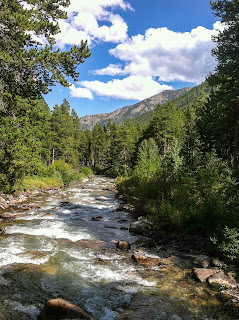
2.) This photo was taken by Cole Broadus. This is a great example of the rule of thirds and layering. I would have cropped the picture a little more though. I would have taken out the wheat in the foreground and make the trees the foreground, have the black hills as the midground, and the mountains in the background. Also, I would have probably cropped off some of the left side of the picture so that the mountains would be framed in the center better.

3.) This is a photo by Alicia Cadrette. I really like this photo. She captured the movement of the mud so well and kept it in focus as well as the rock on the left. She has beautiful color in the rock to the left as well which only adds to it. I believe that she used the appropriate settings for capturing this, and I cannot honestly say anything that I would have done differently.

4.) This is a photo taken by Katie Purgay. I really enjoy this photo. She did a great job at lengthening the exposure and getting the water to look like it does. I also believe that she framed the photo very well and the content being in black and white was a great choice with there being a lot of snow and ice. It adds wonderful contrast. The picture additionally flows really well working its way from the front right corner to the mountain and sky in the back left and back again through the pine trees.

5.) This is a photo taken by Nancy Robinson. This is a great shot of the mountains and its reflection in the water. I really like how the reflection is broken up by the ice on the water as well. She has great colors throughout adding contrast to this photo. Something I may have done differently is attempt to crop out the thin tree on the left side. It is very distracting and I feel takes away from the remainder of the picture.

6.) This photo was taken by Cody Russell. This would not be that bad of a picture if it were not for the giant human shadow. It is extremely distracting and is not part of nature. I don't understand why he would not have simply cropped the photo so that this shadow would not be seen. It's very simple and then the subject would actually be of the bird.

7.) This photo is taken by Rich Umfleet. Sorry Rich but this photo is terrible. You have so many other good pictures I just don't understand why you would have used this one. If it were not for you explaining that there was a stream back behind the trees I would have no idea what that large spot of blue and white was. Absolutely nothing is in focus and it is nauseating to look at. Once again sorry Rich a lot of your other photos are great but this one is horrible.

8.) This photo was taken by Shelby Jurewicz. I really enjoy this picture. The black and white really adds to the calm seriousness of it all especially with the snow falling as well. Something I do suggest it cropping out the buffalo furthest to the left. Nothing against the buffalo but the dead trees behind it are very distracting to the remainder of the photo.

9.) This photo was taken by Mike Eggen. As Mike said in his presentation, something must've gone wrong here and accidentally added grain. This would've been a great photo too. All the different colors with the snow covered branches, the sunset, and the blue sky create great framing and a knowledge of the rule of thirds. But yet, the graininess of it all is the horrible downfall.

10.) This photo was taken by Tyler Reed. I think this is an awesome picture. The sun just barely peeking through that cloud coverage is just awesome. The thermal feature adds more to the depth of field. I think that it was framed really well and is an all around great picture.


































